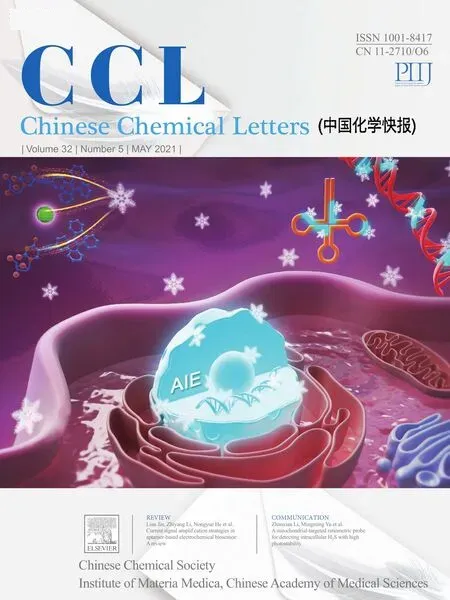Editorial: Green organic synthesis
In 1998,Paul Anastas and John Warner defined 12 Principles of Green Chemistry, aiming at cleaner processes, safer products and increasing use of renewable rather than fossil resources.With the growing awareness of environmental issues, the international chemical community is driven to develop novel and environmentally friendly synthetic strategies for the replacement of inefficient and pollutional chemical processes.Delightedly, a lot of ecofriendly synthetic methodologies have been established over the past decades.
This Virtual Issue is divided into three sections, concentrating on the Twelve Principles of Green Chemistry.
The first section (multicomponent reactions) is specifically concerned with the 2ndand 8thPrinciple of Green Chemistry.Multicomponent reaction is the best choice for atom-and stepeconomic strategy for constructing diverse molecules through a combination of three or more simple substrates in a one-pot operation, which can maximize the buildup of structural and functional complexity, reduce waste, and increase safety.Xiaopeng Zhang and Guisheng Zhang’s group described the selenium-catalyzed multicomponent reaction of 1,2,3-thiadiazol-5-amines,amines and carbon monoxide for the synthesis of 1,2,3-thiadiazol-5-ylureas[1].Wei Wei and coworkers reported the construction of α-aminophosphine oxides through a silver-mediated three-component reaction of propargyl alcohols,aromatic amines and H-phosphine oxides [2].Shun-Yi Wang and Shun-Jun Ji disclosed the TFA-promoted multicomponent reaction of aryldiazonium, Na2S2O5and thiols to prepare thiosulfonates [3].
The second section (green solvents) is specifically concerned with the Principle of Green Chemistry.Nowadays, the majority of synthetic processes take advantage of petroleum-based solvents(often also highly toxic)so large that they can easily constitute up to 90% of the mass of the reaction system.The usage of green solvents, such as water, biomass-derived solvents, ionic liquids,deep eutectic solvents, instead of petroleum-based solvents has received particular attention in both the research community and the chemical industry.Lei Yu’s group reported the Ca(OH)2-catalyzed Claisen-Schmidt condensation reaction with EtOHwater mixed solvent as the reaction medium [4].Zhiyong Wang and colleague developed the activated carbon catalyzed synthesis of pyrrolo[1,2-α]quinoxaline derivatives in water [5].Wei-Min He and colleagues established the synthesis of 2-sulfonylquinoline with the water as the promoter and reaction medium[6].With 2-Me-THF as the sole solvent,the Ni-catalysed C--O bond reduction of 2,4,6-triaryloxy-1,3,5-triazines and NaI-catalysed S-thiocarbamation of isonitriles was achieved by Mingyang He [7] and Wei-Min He[8],respectively.Lifen Peng et al.presented a review of the use of deep eutectic solvents [9].
The third section (visible-light photocatalysis and electrosynthesis) is specifically concerned with the 6thPrinciple of Green Chemistry.Visible-light photocatalysis has been considered as an eco-friendly and sustainable strategy for promoting chemical transformations because visible-light is a low-cost,abundant,and infinitely available renewable energy.Zhenhua Jia and coworkers summaried recent development of the photo-promoted organic reactions under transition metal- and photosensitizer-free conditions [10].Jie Wu’s group reviewed the recent advances for photoinduced C--C bond cleavage of cycloketone oximes [11].Cheng Guo and colleagues developed the photochemical synthesis of α-ketoamides and quinoxalines in the absence of external photocatalysts [12].Xiuling Cui and Jingyu Zhang reported the photochemical synthesis of sulfonylmethylated imidazopyridines with Ir(ppy)3as the photocatalyst[13].Wei Wei’s group described the visible-light-induced synthesis of sulfonylated benzofurans with Eosin Y as the photosensitizer [14].Cheng Guo and Jun Sun achieved the visible-light-induced spirocyclization reaction of propynamide and thiophenols with Pd/ZrO2as the recyclable photocatalyst [15].Shangdong Yang et al.disclosed visible-lightinduced semipinacol rearrangement reaction with fac-Ir(ppy)3as the photocatalyst [16].Jianguo Feng and Wenchao Yang reported the visible-light-induced synthesis of 2-phosphoryl benzothiazoles by using Rose Bengal as the photosensitizer [17].Xianjun Lang and coworkers developed the visible-light-induced aerobic oxidation of thiols to disulfides under external photocatalyst-free conditions [18].Bing Yu and Xiao-Lan Chen reported the visiblelight-promoted oxidative decarboxylation of arylacetic acid with 4CzIPN as the photosensitizer [19].Lei Yu and Chenliang Su disclosed the visible-light-induced reduction of aryl halides in the presence of 5CzBN as the photosensitizer [20].Zu-Li Wang and coworkers reported the visible-light-induced cyclization of o-(allyloxy)arylaldehydes with sulfinic acids with Na2-Eosin Y as the photosensitizer [21].
Organic electrochemistry, which achieves redox transformations with renewable electricity instead of chemical oxidants or reductants,has gained considerable traction in the past few years owing to its inherent cleanability, sustainability and tunability.Jianwei Sun’s group reported the electrochemical multicomponent reaction of olefins, sulfinic acids and alcohols [22].Kun Xu and Jiajing Tan developed the electrochemical selenocyanation of imidazo[1,5-a]quinolones [23].Zhiyong Wang and Zhenggen Zha described the synthesis of α,α-dihaloacetophenones through electrochemical oxyhalogenation of alkynes [24].
The design of eco-friendly and sustainable synthetic protocols that utilize ubiquitous and easily available raw materials and could be in conformity with the green chemistry principle is a highly desirable and continuous effort in organic synthesis.The Green Organic Synthesis Virtual Issue introduces readers to some new advancements on multicomponent reactions, green solvent, and visible-light-induced organic transformations, electrochemical organic synthesis and take Chinese Chemical Letters as a platform to share their results with their peers.
And finally,we would appreciate the help and support from the authors, reviewers and the editorial team of Chinese Chemical Letters for this great special issue.
Declaration of competing interest
The authors report no declarations of interest.
 Chinese Chemical Letters2021年5期
Chinese Chemical Letters2021年5期
- Chinese Chemical Letters的其它文章
- Molecular recognition triggered aptazyme cascade for ultrasensitive detection of exosomes in clinical serum samples
- Synthesis of sponge-like TiO2 with surface-phase junctions for enhanced visible-light photocatalytic performance
- Zn-based metal organic framework derivative with uniform metal sites and hierarchical pores for efficient adsorption of formaldehyde
- High active amorphous Co(OH)2 nanocages as peroxymonosulfate activator for boosting acetaminophen degradation and DFT calculation
- Effects of the molluscicide candidate PPU06 on alkaline phosphatase in the golden apple snails determined using a near-infrared fluorescent probe
- A lysosomal polarity-specific two-photon fluorescent probe for visualization of autophagy
